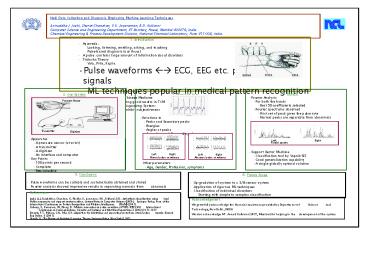Nadi Data Collection and Diagnosis Employing Machine Learning Techniques - PowerPoint PPT Presentation
1 / 1
Title:
Nadi Data Collection and Diagnosis Employing Machine Learning Techniques
Description:
Computer Science and Engineering Department, IIT Bombay, Powai, Mumbai 400076, India. ... Pulse waveforms ECG, EEG etc. physiological signals ... – PowerPoint PPT presentation
Number of Views:125
Avg rating:3.0/5.0
Title: Nadi Data Collection and Diagnosis Employing Machine Learning Techniques
1
Nadi Data Collection and Diagnosis Employing
Machine Learning Techniques Aniruddha J. Joshi,
Sharat Chandran, V.K. Jayaraman, B.D.
Kulkarni Computer Science and Engineering
Department, IIT Bombay, Powai, Mumbai 400076,
India.Chemical Engineering Process Development
Division, National Chemical Laboratory, Pune 411
008, India.
-
1. Introduction - Ayurveda Looking, listening, smelling, asking,
and touching Pulse-based diagnosis (our focus) - A pulse contains large amount of information
about disorders - Tridosha Theory Vata, Pitta, Kapha
- Pulse waveforms ?? ECG, EEG etc. physiological
signals ML techniques popular in medical pattern
recognition - Ayurveda ?? Traditional Chinese
Medicine Researchers already getting good
results in TCM - Our goal Present a Pulse Diagnosing
System Quantitative basis, and inhibit
subjectiveness
4. Results
2. Our System
3. Obtained Data
- Fourier Analysis
- For both the hands
- Best 50 coefficients selected
- Fourier spectrums observed
- First set of peak gives the pulse rate
- Normal peaks are separable from abnormals
Pressure Sensor
- Variations in
- Peaks and Secondary peaks
- Energies
- Angles at peaks
- Ascending and Descending slopes
Transmitter
Digitizer
- Apparatus
- A pressure sensor (at wrist)
- A transmitter
- A digitizer
- An interface and computer
- Key Points
- 100 points per second
- Complete
- Reproducible
Left
Right
Fourier spectra
- Support Vector Machine
- Classification tool by Vapnik95
- Good generalization capability
- A single globally optimal solution
Left
Right
Left
Right
Normal pulse waveforms
Abnormal pulse waveforms
- Other parameters
- Age, Gender, Profession, symptoms
- 5. Conclusion
- Pulse waveforms can be suitably and
systematically obtained and stored - Fourier analysis showed impressive results in
separating normals from abnomals
- 6. Future Scope
- Up-gradation of system to a 3/9-sensor system
- Application of rigorous ML techniques
- Classification of individual disorders Starting
with simple to complex classification
References. Joshi, A.J., Rajshekhar, Chandran,
S., Phadke, S., Jayaraman, V.K., Kulkarni, B.D.
Arrhythmia classification using local Holder
exponents and support vector machine. Lecture
Notes in Computer Science (LNCS-), Springer
Verlag, Proc. of the International Conference on
Pattern Recognition and Machine Intelligence
(PReMI) (2005). Lisheng, X., Kuanquan, W.,
Zhang, D. Modern researches on pulse waveform of
TCPD. IEEE 2002 International Conference on
Communications, Circuits and Systems and West
Sino Expositions 2 (2002) 10731077. Ernesto,
F.T., Myriam, C.H., Max, E.V. Algorithm for
identifying and separating beats from arterial
pulse records. Biomed Eng Online. 4 (2005).
Vapnik, V. The Nature of Statistical Learning
Theory. Springer-Verlag, New York (1995)
Acknowledgment. We gratefully acknowledge the
financial assistance provided by Department of
Science and Technology, New Delhi, INDIA We
also acknowledge Mr. Anand Kulkarni (UICT,
Mumbai) for helping in the development of the
system

